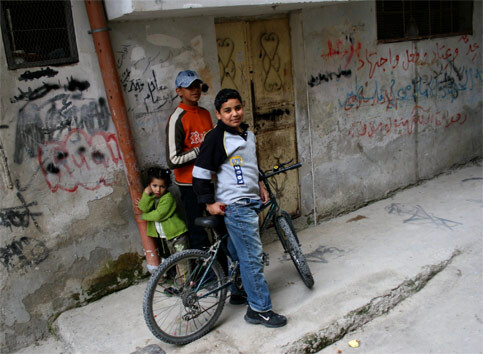The Electronic Intifada 20 June 2007

Children stand in front of the Tulkarem refugee camp, West Bank, 7 April 2007. (Tom Spender/IRIN)
JERUSALEM, 20 June 2007 (IRIN) - Some 4.4 million Palestinians remain refugees nearly 60 years after the start of the 1948 war.
As the world marks World Refugee Day on 20 June, about one third of these refugees still live inside camps, while an even larger proportion continue to receive aid and relief services, primarily from UNRWA, the UN Agency for Palestinian Refugees.
Observers say the situation in the occupied Palestinian territories has worsened over the past year due to the violence, intense infighting in the Gaza Strip and the international economic boycott on the Palestinian Authority, which lasted over one year and was only lifted earlier this week.
Darrin Waller, chief executive officer of Medical Aid for Palestinians (MAP-UK), a London-based humanitarian organisation, said that while all Palestinians had been affected by the turmoil in Gaza, including Israeli military incursions, refugees suffered most. “There is a particular impact on the refugees, as they are the most vulnerable within the community,” Waller said.
In the West Bank, movement restrictions imposed by the Israeli military are a growing problem.
“The West Bank restrictions should be lifted. There is a trend towards increasing restrictions on Palestinian movement,” said Filippo Grandi, deputy commissioner general of UNRWA in Jerusalem, who said his staff were negatively affected by the developments.
“Humanitarian access is an immediate problem in Gaza. The acute humanitarian problems need to be addressed immediately in Gaza,” he said.
Lebanon
In northern Lebanon refugees are caught in the crossfire between the Lebanese army and extremist groups,” he said.
Lebanon hosts over 400,000 refugees and the fighting in Nahr al-Bared camp has had an impact on many Palestinians. Some 30,000 have fled the camp in the past month.
“The conditions have deteriorated with what’s going on in Nahr al-Bared. It’s affecting people all over, as relatives and friends are hosting refugees fleeing the fighting,” said Hoda al-Turk, an UNRWA information officer in Beirut.
“There is extreme overcrowding in the camps the refugees have fled to,” al-Turk added, noting that the Baddawi camp now hosted twice as many people as it did before.
Palestinians in Lebanon face a particularly difficult situation, as local law places extreme limitations on their employment opportunities, basically preventing most refugees from working in the camps, aid workers said.
Syria
In Syria, where some 460,000 Palestinian refugees reside, the conditions are better, many Palestinians said.
“Syria is an example for other host countries. Here there is no discrimination, we get the same treatment. We are on an equal footing with the Syrians with regard to employment, health and education,” a Palestinian refugee told IRIN in Damascus.
Jordan
Jordan hosts about 1.8 million Palestinian refugees including some 130,000 people who fled from Gaza in 1967. These refugees, as opposed to most Palestinians in Jordan, are not citizens, and therefore face restrictions on access to higher education and jobs.
“They are deprived of their basic rights. They have a very difficult time working in the private and public sectors, and mostly tend to work as unskilled labourers,” says Oroub el-Abed, who has done extensive research on the refugees.
Egypt
There are about 50,000 Palestinian refugees in Egypt who are not registered with UNRWA. They cannot attend public schools and are not allowed to work.
“They are treated as foreigners,” Abed said. “Many reside in Egypt illegally, without any rights.”
Iraq
Similarly, Palestinians in Iraq are facing an extreme crisis. Over 10,000 have fled Iraq since the US-led invasion and over 1,000 remain stranded at the Syrian-Iraqi border, living in camps where the “humanitarian conditions are horrific”, said Waller of MAP-UK.
Double displacement
Some 800,000 Palestinians fled the 1948 hostilities to refugee camps in Jordan, Lebanon, Syria, the West Bank and Gaza Strip, and nearly 200,000 of them were forced to flee again in the June 1967 war.
UNRWA will mark World Refugee Day by focusing on the plight of those who were twice displaced.
In a camp outside Amman, Jordan, one Palestinian tells his family’s story of repeated migration.
“I was born in Ramla, in the costal area of Palestine. In 1948 we fled to Ramallah, in the West Bank. Then, we moved again to Ein a-Sultan camp, outside Jericho. After 1967, we fled again, to here,” said Yousef Salem Daoud, aged 68, who currently lives in Nasr camp.
“Where is the justice in this? Where are our rights,” he asked.
UNWRA financial burden
Karen Koning Abu Zayed, UNRWA’s commissioner general, recently noted the achievements of UNRWA and the host countries.
“The literacy rate for Palestinians in the occupied Palestinian territory is 92.4 percent, compared to roughly 67 percent for the Middle-East region and communicable diseases have been eradicated,” she said.
However, the increased financial burden UNRWA faces, including an expected US$200 million deficit this year, means the agency is having a hard time improving services for the refugees.
“This is going to be a key issue for the next year,” said Grandi.
This item comes to you via IRIN, a UN humanitarian news and information service, but may not necessarily reflect the views of the United Nations or its agencies. All IRIN material may be reposted or reprinted free-of-charge; refer to the copyright page for conditions of use. IRIN is a project of the UN Office for the Coordination of Humanitarian Affairs.
